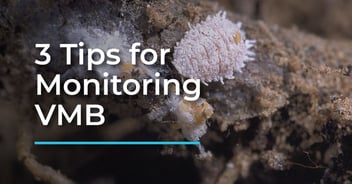For this blog post, we’re going back to the basics of mating disruption and answering some of the most frequently asked questions about mating disruption.

A Semios pheromone aerosol dispenser hanging in a pistachio orchard
10 frequently asked questions about mating disruption:
- What is a pheromone?
- What is mating disruption?
- How does mating disruption work?
- Why use mating disruption?
- How does orchard or vineyard shape and size affect mating disruption efficacy and limitations?
- Do I still need to apply insecticides?
- What options are available for mating disruption dispensers?
- Will mating disruption attract pests to my orchard?
- How do I interpret trap counts under mating disruption?
- Can pests develop resistance to mating disruption?
1. What is a pheromone?
Insects communicate with each other through chemical signals.
A pheromone is a chemical that is used for communication between the same species. They can be further described based on what they are used for, such as pheromones to signal danger or dominance.
Sex pheromones are released for the purpose of sexual reproduction. Often the purpose is to attract the opposite sex. Sex pheromones produced by the female are most commonly characterized and used for mating disruption and lures in traps.
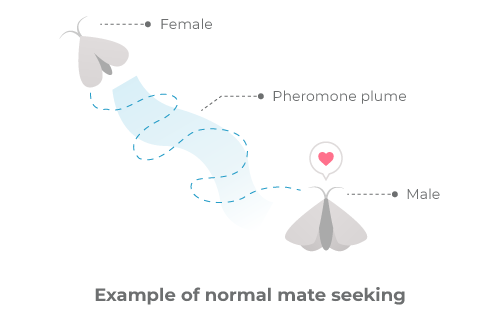
2. What is mating disruption?
Mating disruption is when a synthetic sex pheromone is released into the atmosphere for the goal of disrupting chemical communication between organisms and mating behaviors that result from said communication. By impacting mating, the reproduction of offspring is reduced.
3. How does mating disruption work?
Mating disruption can work in different ways. These include:
-
Camouflage:
High volumes of pheromone in the atmosphere makes males unable to locate plumes emitted by a female.
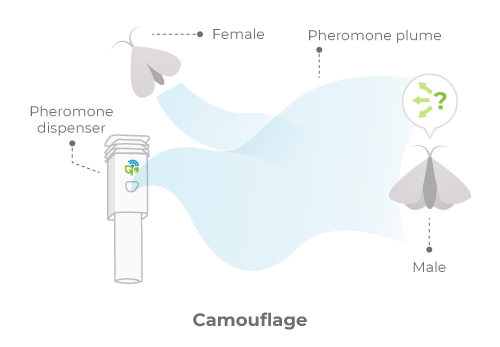
-
False trail following:
Males can follow plumes emitted by a female or a dispenser, but mating is reduced because males spend time and energy following false dispenser trails that do not lead to a female.
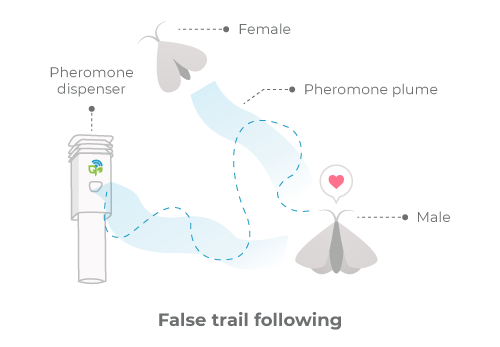
-
Sensory imbalance:
Pheromones can be made up of multiple chemical components, and insects are adapted to respond to specific ratios of these components. Releasing high quantities of a particular component can alter the ratio of chemical components in the atmosphere, making it so that males no longer recognize plumes as their own species.
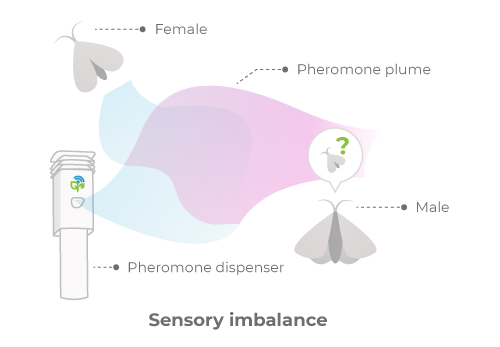
-
Desensitization:
Constant exposure to pheromone can make males unresponsive to pheromones.
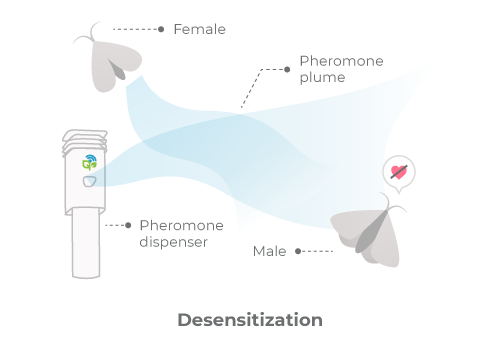
Mating disruption can work through one or a combination of these methods and will depend on the insect and pheromone formulation. The mechanisms by which mating disruption operates are not always well understood, though mating disruption has still proved to be a valuable tool in an integrated pest management (IPM) program.
4. Why use mating disruption?
Mating disruption has a number of benefits including:
-
Safer for humans and more sustainable for the environment:
Synthetic pheromones are based on chemicals that are naturally found, so they are less toxic than traditional insecticides. Due to their low toxicity, mating disruption products will have very low or no re-entry and post harvest intervals.
-
Safe for beneficial insects:
Pheromones are specific to species, therefore it has little or no impact on non-target species including beneficial insects.
-
Resistance management:
Using additional tools within the IPM tool box can reduce the selective pressure from any one type of management tactic.
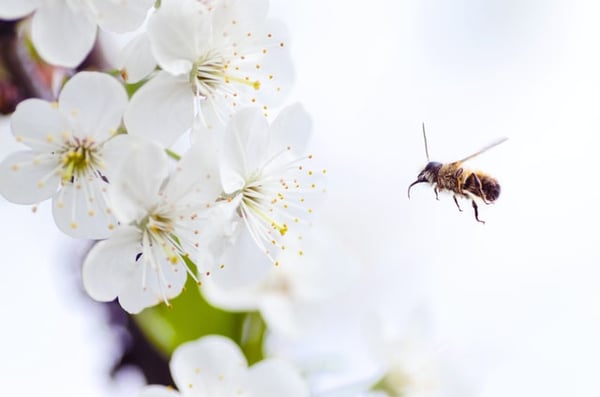
Mating disruption allows growers to target specific pests without having to worry about affecting the population of beneficial insects, such as bees.
5. How does orchard or vineyard shape and size affect mating disruption efficacy and limitations?
A number of factors should be considered for determining whether mating disruption is right for your orchard or vineyard.
-
Orchard or vineyard size:
Mating disruption does not stop pests from migrating in from neighboring areas. Due to the risk of re-infestation of borders, the impacts of mating disruption are most notable on blocks larger than 10 acres or when farmers collaborate on adopting area-wide mating disruption.
-
Orchard or vineyard shape:
Triangular blocks and long skinny blocks have more edges, putting them at higher risk for damage of edge effects. In addition, certain shapes and row orientations will be impacted by the wind differently. For example, a region may mostly experience prevailing winds from the NW direction during the growing season. As a result, block edges that have a SW-NE orientation will be more prone to wind movement, making them areas that may require additional attention. One way that some growers have combatted this is to increase dispenser application density on block edges.
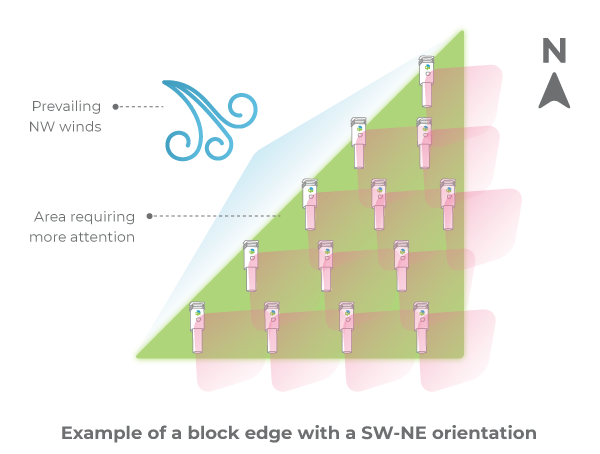
This example illustrates how in a region with prevailing NW winds, the NW block edge receives a weaker plume coverage and may require additional attention.
-
Canopy density:
The canopy within the orchard helps mating disruption along by acting as a windbreak, but foliage can also in some cases also act as a pheromone sink that will absorb and re-release pheromone. Orchards or vineyards with less dense canopies such as newly planted blocks, or areas in an orchard or vineyard with missing trees and vines are therefore more prone to pheromone being blown out.
-
Orchard or vineyard isolation:
Isolation from other pest sources can make mating disruption more effective for some orchards and vineyards. Isolation can be achieved if a site lacks neighbors with susceptible crops or is located in a valley.
6. Do I still need to apply insecticides?
Mating disruption works best when pest pressure is low to moderate.
Despite the difficulty in locating mates under mating disruption, under high pest pressure, adults are more likely to have chance encounters. It is therefore important to regularly monitor your fields and to assess how successful pest populations have been reduced by mating disruption before cutting back sprays.
Mating disruption can both reduce as well as limit the growth of a population. When utilized with an effective all around strategy, mating disruption may lead to a reduced need for sprays, but sprays may still be required when pest pressure is high.
7. What options are available for mating disruption dispensers?
There are a number of mating disruption options out there, each with its own pros and cons. The most commonly available options are described below, but other forms of mating disruption dispensers include flakes, fibers, and electrostatic powders that adhere to the bodies of insects.
| Dispenser Type | Pros | Cons |
|
Hand Applied A dispenser that releases pheromone slowly over time. Usually a material impregnated with pheromone, or a reservoir of pheromone released through a membrane. Many different formats including twist ties, clips etc. |
|
|
Hand Applied (Meso Type) Same as regular hand applied dispensers, but usually with a higher quantity of pheromone so that it can be applied at lower densities |
|
|
| Sprayable (microencapsulated) A liquid formulation that is applied with standard spray equipment |
|
|
| Fixed-rate Aerosol Emitters Pheromone in aerosol can, that is placed into a cabinet with a motor that will dispense pheromone at regular intervals. |
|
|
| Semios' Variable-rate Aerosol Emitters Pheromone in aerosol can, that is connected to a network and placed into a cabinet with a motor. Pheromones are dispensed at rates that are automatically adjusted to your orchard's pest activity. |
|
|
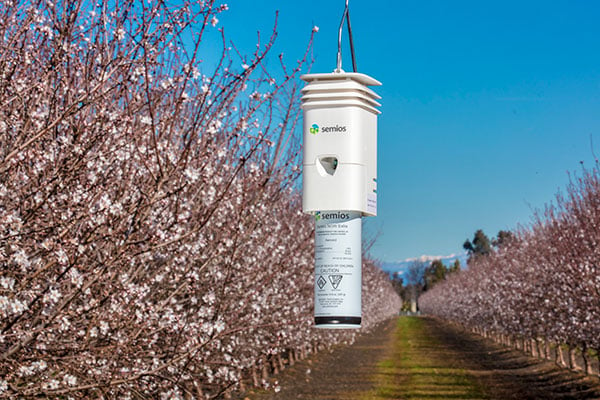
Example of an aerosol emitter
8. Will mating disruption attract pests to my orchard?
This will depend on the pheromone and the mechanism by which mating disruption is deployed. Some pheromones are non-attractive, and work through mechanisms such as sensory imbalance.
Other pheromones used in mating disruption are attractive and work by competing with females (e.g. false trail following). However, these attractive pheromones commonly used in mating disruption are only attractive to males and therefore should not draw in females from neighboring sources.
9. How do I interpret trap counts under mating disruption?
Trap catch interpretation under mating disruption depends on whether the lure in the trap attracts one or both sexes:
-
Traps with lures attracting only males:
These traps will tell you how effectively your mating disruption is working. Orchards under mating disruption can experience trap shut down of > 90% for some pests. That being said, it is important to keep note of where your trap is located relative to your mating disruption dispensers. A trap that is located on an edge will have higher trap captures than one located in the middle of a block.
-
Traps with lures attracting males and females:
These traps will give you a better sense of your pest phenology when using mating disruption. In addition to females being able to effectively locate traps, the kairomones used in many of these lures will also allow for males to locate the traps sufficiently. Therefore, you can still expect regular trap captures.
10. Can pests develop resistance to mating disruption?
Resistance to insecticides occurs when resistant individuals pass on resistance genes to their offspring, while susceptible individuals are unable to because they die before reproducing. Over time, these genes for resistance can become a dominating trait in a population. The goal for mating disruption is to prevent or reduce mating in the first place. If an insect has a mutation that allows them to be unresponsive to a synthetic pheromone, this will affect their mating success as they are in turn unresponsive to wild individuals, making it unlikely that ‘unresponsive’ genes will be passed on.
In the 40 years since the commercial introduction of mating disruption, there has been only one reported case of loss of mating disruption efficacy in a commercial setting, for the smaller tea leafroller moth Adoxophyes honmai in Shizuoka Prefecture in Japan. Resistance developed over a period of 10 years and it is believed that resistance developed due to the synthetic pheromone being based on one component of a complex pheromone blend. Efficacy was restored once a full blend was used.
Have any more questions about mating disruption?
If you have any questions, leave a comment below or contact us directly.
References & resources
Orchard IPM - Using Pheromones for Monitoring and Mating Disruption
Suckling, D. M., G. Karg, and S. J. Bradley. 1996. Apple foliage enhances
mating disruption of light-brown apple moth. J. Chem. Ecol. 22: 325–341.
WSU Tree Fruit Page on Mating Disruption
Related posts
Understanding Variable Rate Mating Disruption
Semios Pheromone Solutions - California
Semios Pheromone Solutions - Washington

-Effective-Preview-Image.jpg?width=352&name=Is-Mating-Disruption-for-Vine-Mealybug-(VMB)-Effective-Preview-Image.jpg)
